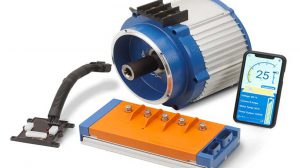QUESTION: PL. Asks: Can you please simplify IQ controller testing.
ACCORDING TO ROGER: Okay, I have written about IQ systems before and think I have a way of breaking testing down a tad more simple. Usually, what I find is everyone wants that “here it is answer” and just tell me what I need. Unfortunately it does not work that way. Certain tests have to be performed in order to find the system fault. If we understand the sequence of operation it all falls into place. Knowing what takes place at different points in the system guides us through the trouble shooting process. It is not just a matter of testing a controller. I want to make that clear. It is a system, and that system has to work in order for the controller to function correctly. So let’s go through the sequence and sort things out.
Let’s look for example at a simplistic schematic of that system. In my mind when looking at trouble shooting I have to think about how voltage gets from point A to point B. I know I have to have a nominal voltage of 48 volts for the car to run. So we start at the battery pack. I confirm we have 48 volts at the first positive connection to the car. Shown in the schematic at CON. Notice, at that point there is a gap and that gap represents the contacts inside the contactor. Let’s close that contact. Now we have positive voltage at B+ and A1 on the motor/controller B+. How we close that contact is part of the activation circuit that we will discuss later. It would also make sense we have positive voltage at A2. What if voltage is not at A2? That would mean voltage is not flowing through the motor armature. Meaning, the brushes are not making contact or a wire is open. At that point you have to repair that. We also have to have a negative potential for the controller to function. Confirm you have a negative potential at B- on the controller. If you do not either that cable is open or the car has a defective battery. No way around that. Not to mention that positive we just talked about cannot be there either. So again, make sure you have a functioning battery pack. Next, you will have battery positive at F1 on the motor. It would also make sense you have battery positive at F2. If voltage is missing at F2, a brush is open or a connection is open. Understand, at this point we have only done one thing and that is activate the contactor. If the contactor does not activate we will cover that later. We have proven that potential voltage is present in the power circuit. Note: you must have equal voltage on both large contactor terminals. If you do not, you have issues with the contactor. Repair or replace the contactor. For that system to function a negative potential has to be applied at A2 and F2. This is a shunt wound motor system so understand the armature and fields are separate and function separately. How we make that negative to the motor is the interesting point.
Now that we have a basic sequence let’s close that loop. This is where the activation side picks up. Looking at the schematic we have positive voltage applied to the run/tow switch, fuse and key switch. You must confirm that. The run/tow switch also applies positive voltage to pin 9 on the controller 16 pin connector. If pin 9 is not positive the run/tow circuit is open. Repair it. Closing the key switch we apply battery positive to the foot switch, forward/reverse switch, back up alarm, and pin 10 on the controller. Confirm that. Missing voltage anywhere then stop at that point and repair it. If we close the foot switch we now apply positive voltage to pin 6, contactor, and forward or reverse (depending on direction selected. Confirm that, and if missing repair that. Let’s say all the potentials are there. But the contactor does not activate. This is the why and how become part of all this. Positive voltage is present so what is missing is a negative potential to the contactor. We can see that by looking at pin 12 as being that potential. In order for that potential to occur we have to make sure all other pin potentials are present. Pins 5, 9, 8 or 16 depending on direction chosen, and pin 10. If any of those pins are open (no voltage) there is a wiring issue/switch not controller. Once confirmed then push the accelerator pedal and confirm you have positive voltage at pin 6. If not there is a wiring/foot switch issue. If all things are confirmed then we move on to the next sequence. Understand everything so far has been about a sequence of applied voltages. There are two other areas that can shut the controller logics down and simulate activation problems. We must have a signal voltage from the potentiometer and the speed sensor. So often these two areas are over looked. Check for positive voltage at pin 1 of five volts. Check from pin 3 to pin 2 with pedal up you should see 0 volts. As you depress the pedal you should see voltage increase to 5 volts pedal down. If not there are potentiometer issues or wiring issues. All okay, then move to the speed sensor. Connect to pin 13 (low side) and is battery negative to pin 15 and you should see 15 volts. If that voltage is missing either the wiring or controller is defective based on all the other pin voltage we just saw are correct. Check from pin 13 to pin 14 with one rear wheel off the ground. Slowly turn that wheel by hand and watch the voltmeter. You should see a pulsing 0 to 5 volts. If that voltage is missing the sensor is defective.
So you think we are done well not yet. One more sequence. Connect to pin 5 and confirm you have 48 volts positive. If you do not either the wire is broken or the on board computer is defective. You can cut the wire at pin 5 and connect to battery positive to by-pass the lock out for testing. If the car runs replace the computer. If it does not run replace the controller. Simple and easy to do and you are done.
Note: With all pins and components in working order what happens is a pulsing negative is applied at F2 on the motor and A2. That is how you complete the motor circuit to battery negative is through the controller. This completes the sequence. Understanding this is how you troubleshoot the controller. It is all about testing what is going on around the controller. Procedure and sequence all goes together. Before replacing the controller make sure the motor fields are not shorted!











